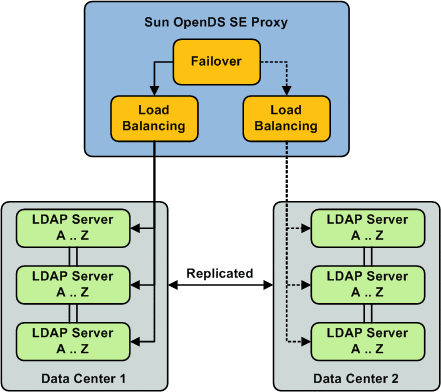| Exit Print View | |
Sun OpenDS Standard Edition 2.2 Deployment Planning Guide |

|
1. Overview of Sun OpenDS Standard Edition
2. Overview of the Directory Server
3. Overview of the Proxy Server
4. Building Blocks of the Proxy Server
5. Example Deployments Using the Directory Server
6. Example Deployments Using the Proxy Server
Deciding Your Proxy Deployment Type
Configuration 1: Simple Load Balancing
Configuration 2: Simple Distribution
Configuration 4: Distribution with Load Balancing
Configuration 5: Distribution with Failover Between Data Centers
7. Simple Proxy Deployments Using the Command Line Interface
When deploying failover between data centers, you are essentially deploying two levels of load balancers within the Sun OpenDS Standard Edition proxy. In this deployment, the data centers are replicated and the remote LDAP servers within the data centers are also replicated. The first load balancing element of the deployment can be either failover or saturation. The example assumes failover algorithm is selected for the initial load balancing element.
As illustrated in Figure 6-3, all of the requests are routed by the failover load balancer through the main route, to a second load balancing element, which sends the request to a server within Data Center 1. If Data Center 1 goes down or is degraded, then the traffic is routed by the failover load balancer to the backup route, to a server in Data Center 2.

The requests are routed to the remote LDAP servers within the data centers based on the load balancing algorithm set. The load balancing algorithm can be different for each data center. For example, you can set the load balancing in Data Center 1 as proportional, while the load balancing algorithm in Data Center 2 is set as saturation.
This type of deployment is typically used when deploying in two geographical areas. This adds high availability of data to a simple load balancing deployment, since not only are the remote LDAP servers replicated, but the data centers are also replicated.
Typically, you would have the two data centers in two different geographical locations. This way, if there was a problem in one location, the data center in the other location would act as backup. Another example would be setting the first load balancer to saturation. This way, if Data Center 1 in one geographical location (for example in one time-zone) becomes saturated, the other data center can pick up the excess traffic.
For more information on the different load balancing algorithms, see Load Balancing Using the Proxy.
For details on deploying this configuration, see Configuring Failover Between Data Centers.